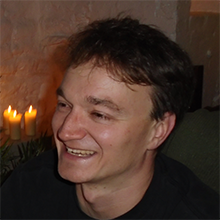Tuesday, 02 April 2019
A new fingerprint technique capable of producing high-resolution images from the most challenging of metal surfaces, including knives and firearms - is already attracting interest from detectives working on cold cases.
Experts at the University of Nottingham in collaboration with the University of Derby, are using highly sensitive, non-destructive Time-of-Flight Secondary Ion Mass Spectroscopy (ToF-SIMS) to develop high resolution fingerprint images from surfaces conventional fingerprint imaging fails to pick up at all.
The research – Exposing latent fingermarks on problematic metal surfaces using time of flight secondary ion mass spectroscopy - has shown the technique is capable of revealing fingerprints in so much detail, defined ridge definition and the position and shape of the sweat pores are clearly visible. In samples stored under ambient conditions they were able to reproduce the fingerprint as long as 26 days after it was originally planted.
“This raises the possibility of being able to reliably visualise fingerprints on surfaces previously thought to be devoid of such crucial evidence. ToF-SIMS imaging has the potential and could be a valuable tool in helping to visualise fingermarks on objects such as stainless-steel knife blades and firearms.”
 Professor James Sharp
Professor James Sharp
The fingerprint
In 1902 London burglar, Harry Jackson, became the first man in England to be convicted for a crime based on fingerprint evidence. Since then fingerprints have been regarded as indisputable evidence. But the case of Shirley McKei in 1999 showed that fingerprint evidence can be flawed.
Over the decades a multitude of techniques have been developed for enhancing the visualisation of hidden fingermarks. But substrates such as simple metals and alloys have stubbornly refused to give up their fingerprint secrets – until now.
Adam Long, Undergraduate Programme Coordinator for Forensic Science at the University of Derby, said: “Fingerprints are incredibly difficult to retrieve from metallic surfaces. This is mainly due to physical and environmental conditions that the prints may be exposed to at the crime scene, the age of the print, as well as how the developing agents react with the surface.
“A common example of the difficulties investigators face, comes from examining fired bullet casings. The high temperatures, pressure and friction caused when a bullet is fired makes fingerprints extremely fragile and this, combined with other factors, often results in their apparent removal or obliteration. This technique is non-destructive and can be used repeatedly to image fingerprint marks without compromising their quality.”
The Study
The research team took fingermarks from six donors, every day for 14 days. The fingerprints were put on to disks of brass, aluminium and stainless steel and treated simultaneously so the effects of ageing could easily be determined.
The results showed that the fingerprints developed using traditional techniques were unreliable. Quality degraded after 8 days. Some prints were unrecognisable within 3 days, and one sample showed no results at all after the 14 days.
Being able to measure a mass of different molecules in an individual sample, the Ion beam from the ToF-SIMS technique was able to detect and visualise the fingerprint secretions in samples up to 26 days after they were taken – the first time this has ever been done.
The results were the same for all donors – irrespectively of gender, age and ethnicity.
The fingermarks used in this study were produced to contain consistent levels of eccrine and sebaceous secretions. However, real-world samples are likely to contain variable amounts of these deposits and further studies are required to demonstrate the applicability of ToF-SIMS to a broader range of fingermarks and samples surfaces.
Combination of expertise
Dr Ian Turner, Associate Professor at the University of Derby said “This research project has shown the impact of combining the expertise of leading physicists and forensic scientists has had on developing fingermarks on this challenging surface.”
This technique is of interest to the East Midland Scientific Operations Unit – Forensic Services who helped develop the conventional marks used in the study.
Story credits
More information is available from Dr James Sharp in the School of Physics and Astronomy at the University of Nottingham, on +44 (0) 115 9515142, james.sharp@nottingham.ac.uk
Notes to editors:
About the University of Nottingham
Ranked 97 in the world and 17th in the UK by the QS World University Rankings, the University of Nottingham is a founding member of Russell Group of research-intensive universities. Studying at the University of Nottingham is a life-changing experience, and we pride ourselves on unlocking the potential of our students. We have a pioneering spirit, expressed in the vision of our founder Sir Jesse Boot, which has seen us lead the way in establishing campuses in China and Malaysia - part of a globally connected network of education, research and industrial engagement.
Nottingham was crowned Sports University of the Year by The Times and Sunday Times Good University Guide 2024 – the third time it has been given the honour since 2018 – and by the Daily Mail University Guide 2024.
The university is among the best universities in the UK for the strength of our research, positioned seventh for research power in the UK according to REF 2021. The birthplace of discoveries such as MRI and ibuprofen, our innovations transform lives and tackle global problems such as sustainable food supplies, ending modern slavery, developing greener transport, and reducing reliance on fossil fuels.
The university is a major employer and industry partner - locally and globally - and our graduates are the third most targeted by the UK's top employers, according to The Graduate Market in 2024 report by High Fliers Research.
We lead the Universities for Nottingham initiative, in partnership with Nottingham Trent University, a pioneering collaboration between the city’s two world-class institutions to improve levels of prosperity, opportunity, sustainability, health and wellbeing for residents in the city and region we are proud to call home.
More news…